Get free scan and check if your device is infected.
Remove it nowTo use full-featured product, you have to purchase a license for Combo Cleaner. Seven days free trial available. Combo Cleaner is owned and operated by RCS LT, the parent company of PCRisk.com.
What kind of malware is DarkCloud?
DarkCloud is a malicious program classed as a stealer. Malware within this classification is designed to steal sensitive information from infected systems. DarkCloud stealer has been observed using sophisticated infiltration and anti-analysis/anti-detection techniques.
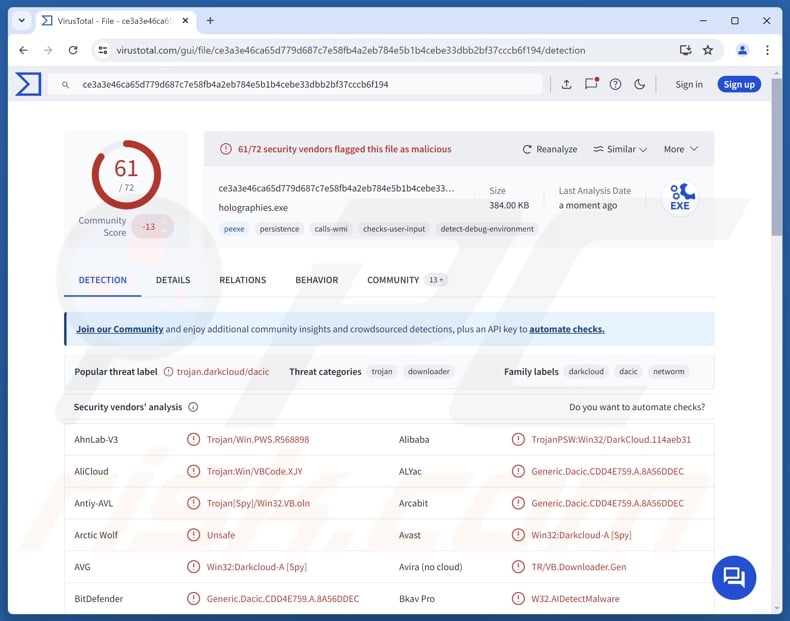
DarkCloud malware overview
DarkCloud has infiltrated systems through three different infection chains. All these processes involve complex protective measures to prevent analysis and detection; nearly every stage is secured.
To expand some on the known chains, they all begin with malspam (malicious spam emails) distributing virulent files. The chains rely on different archive formats – RAR, TAR, or 7Z (7-Zip). The former two contain a JavaScript (JS) file each, while the 7Z – a Windows Script File (WSF).
In the chain involving the JavaScript file, a PowerShell (PS1) file is downloaded/executed, and it then introduces an executable file (EXE) that is the DarkCloud stealer.
The process with the Windows Script File likewise downloads and executes a PowerShell file from the same source, but the file is not the same. In this chain, an executable is written in the temporary file directory (%tmp% folder) under a randomized filename. The PowerShell file is then used to execute the EXE file.
To elaborate on some on the mechanisms used in the chain for protection, heavy obfuscation is used. The DarkCloud payload can be protected employing ConfuserEx – a .NET application protector. In these cases, process hollowing is also utilized – a technique that typically involves the creation of a legitimate yet suspended process, the memory of which is then overwritten with the code of a malicious executable in order to run it rather than the innocuous process.
Instances have been noted wherein DarkCloud's infections relied on AutoIt for system detection evasion. Encryption was used to obfuscate parts of the code as well.
As mentioned in the introduction, DarkCloud is a stealer targeting vulnerable data. It scours specific directories for files of interest (by extension and potentially by keywords like credit card names).
Generally, stealers have the ability to extract information from various applications like browsers, VPNs, FTPs, messengers, password managers, email clients, cryptocurrency wallets, etc. Targeted information may include Internet cookies, personally identifiable details, usernames/passwords, credit/debit card numbers, and so forth.
It must be mentioned that malware developers often improve upon their software and methodologies. Therefore, DarkCloud could be proliferated differently or use other infiltration techniques. Potential future versions of this stealer could have additional/different capabilities and features.
To summarize, the presence of software like the DarkCloud stealer on devices can lead to severe privacy issues, financial losses, and identity theft.
| Name | DarkCloud malware |
| Threat Type | Trojan, stealer, password-stealing virus. |
| Detection Names | Avast (Win32:Darkcloud-A [Spy]), Combo Cleaner (Generic.Dacic.CDD4E759.A.8A56DDEC), ESET-NOD32 (A Variant Of Win32/Spy.VB.OLN), Kaspersky (Trojan-PSW.Win32.DarkCloud.aal), Microsoft (Trojan:Win32/DarkCloud!rfn), Full List Of Detections (VirusTotal) |
| Symptoms | Trojans are designed to stealthily infiltrate the victim's computer and remain silent, and thus no particular symptoms are clearly visible on an infected machine. |
| Distribution methods | Infected email attachments, malicious online advertisements, social engineering, software 'cracks'. |
| Damage | Stolen passwords and banking information, identity theft, the victim's computer added to a botnet. |
| Malware Removal (Windows) |
To eliminate possible malware infections, scan your computer with legitimate antivirus software. Our security researchers recommend using Combo Cleaner. Download Combo CleanerTo use full-featured product, you have to purchase a license for Combo Cleaner. 7 days free trial available. Combo Cleaner is owned and operated by RCS LT, the parent company of PCRisk.com. |
Stealer-type malware examples
We have written about countless malicious programs; JSCEAL, RMC stealer, Leet, SHUYAL, and BOFAMET are merely some of our newest articles on stealers. This software can target specific details only or a broad range of data.
Furthermore, stealer-type programs are often used in combination with other malware. What is more, data-stealing functionalities are prevalent in general.
It must be emphasized that regardless of how malware operates – its presence on a system threatens device integrity and user safety. Therefore, all threats must be eliminated immediately upon detection.
How did DarkCloud infiltrate my computer?
DarkCloud has been spread through email spam campaigns distributing an archive – in the RAR, TAR, or 7Z formats. The RAR and TAR archives contained JavaScript files, and the 7Z – a Windows Script File. However, this stealer could be proliferated using different techniques or formats. Malicious files can be archives, executables, documents (e.g., Microsoft Office, Microsoft OneNote, PDF, etc.), JavaScript, and so on. Merely opening such a file can be enough to trigger the infection chain.
The most widely used malware distribution methods include: trojans (backdoors/loaders), drive-by (stealthy/deceptive) downloads, malicious attachments or links in spam mail (e.g., emails, PMs/DMs, SMSes, etc.), malvertising, online scams, pirated programs/media, dubious download sources (e.g., freeware and third-party websites, P2P sharing networks, etc.), illegal software activation tools ("cracks"), and fake updates.
Furthermore, some malicious programs can self-spread via local networks and removable storage devices (e.g., external hard drives, USB flash drives, etc.).
How to avoid installation of malware?
Caution is paramount to ensuring device and user safety. Therefore, always be vigilant when browsing since the Internet is full of deceptive and malicious content. Approach incoming emails and other messages with care; do not open attachments or links present in suspicious/irrelevant communications.
Additionally, download only from official and trustworthy sources. Activate and update programs using functions/tools provided by genuine developers, as those obtained from third-parties can contain malware.
It is essential to have a reputable antivirus installed and kept up-to-date. This software must be used to run regular system scans and to remove detected threats and issues. If you believe that your computer is already infected, we recommend running a scan with Combo Cleaner Antivirus for Windows to automatically eliminate infiltrated malware.
Instant automatic malware removal:
Manual threat removal might be a lengthy and complicated process that requires advanced IT skills. Combo Cleaner is a professional automatic malware removal tool that is recommended to get rid of malware. Download it by clicking the button below:
DOWNLOAD Combo CleanerBy downloading any software listed on this website you agree to our Privacy Policy and Terms of Use. To use full-featured product, you have to purchase a license for Combo Cleaner. 7 days free trial available. Combo Cleaner is owned and operated by RCS LT, the parent company of PCRisk.com.
Quick menu:
- What is DarkCloud?
- STEP 1. Manual removal of DarkCloud malware.
- STEP 2. Check if your computer is clean.
How to remove malware manually?
Manual malware removal is a complicated task - usually it is best to allow antivirus or anti-malware programs to do this automatically. To remove this malware we recommend using Combo Cleaner Antivirus for Windows.
If you wish to remove malware manually, the first step is to identify the name of the malware that you are trying to remove. Here is an example of a suspicious program running on a user's computer:
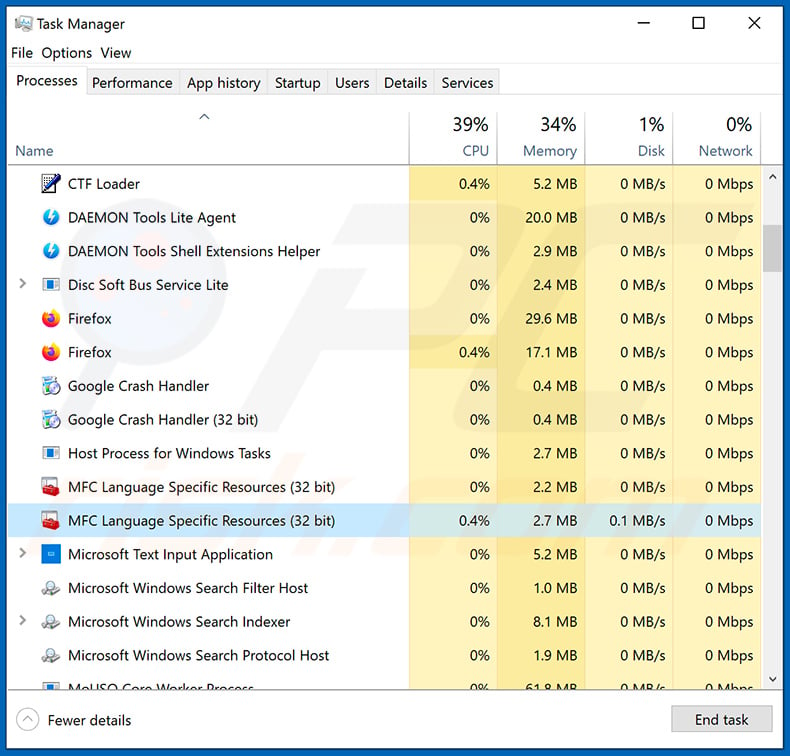
If you checked the list of programs running on your computer, for example, using task manager, and identified a program that looks suspicious, you should continue with these steps:
 Download a program called Autoruns. This program shows auto-start applications, Registry, and file system locations:
Download a program called Autoruns. This program shows auto-start applications, Registry, and file system locations:
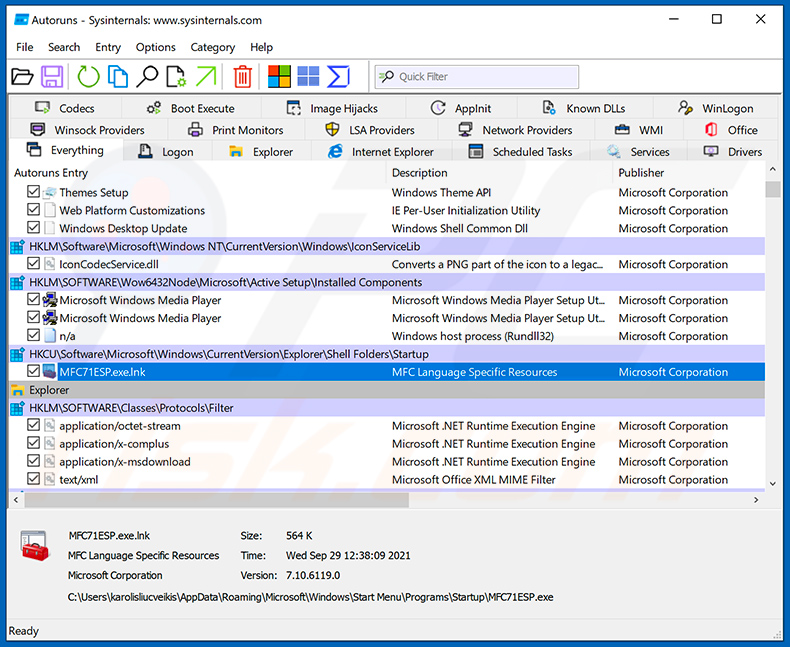
 Restart your computer into Safe Mode:
Restart your computer into Safe Mode:
Windows XP and Windows 7 users: Start your computer in Safe Mode. Click Start, click Shut Down, click Restart, click OK. During your computer start process, press the F8 key on your keyboard multiple times until you see the Windows Advanced Option menu, and then select Safe Mode with Networking from the list.
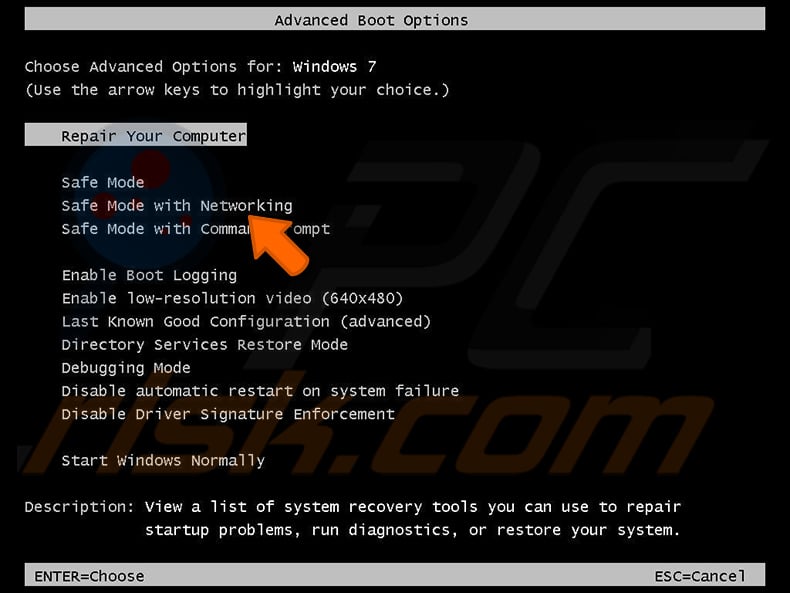
Video showing how to start Windows 7 in "Safe Mode with Networking":
Windows 8 users: Start Windows 8 is Safe Mode with Networking - Go to Windows 8 Start Screen, type Advanced, in the search results select Settings. Click Advanced startup options, in the opened "General PC Settings" window, select Advanced startup.
Click the "Restart now" button. Your computer will now restart into the "Advanced Startup options menu". Click the "Troubleshoot" button, and then click the "Advanced options" button. In the advanced option screen, click "Startup settings".
Click the "Restart" button. Your PC will restart into the Startup Settings screen. Press F5 to boot in Safe Mode with Networking.
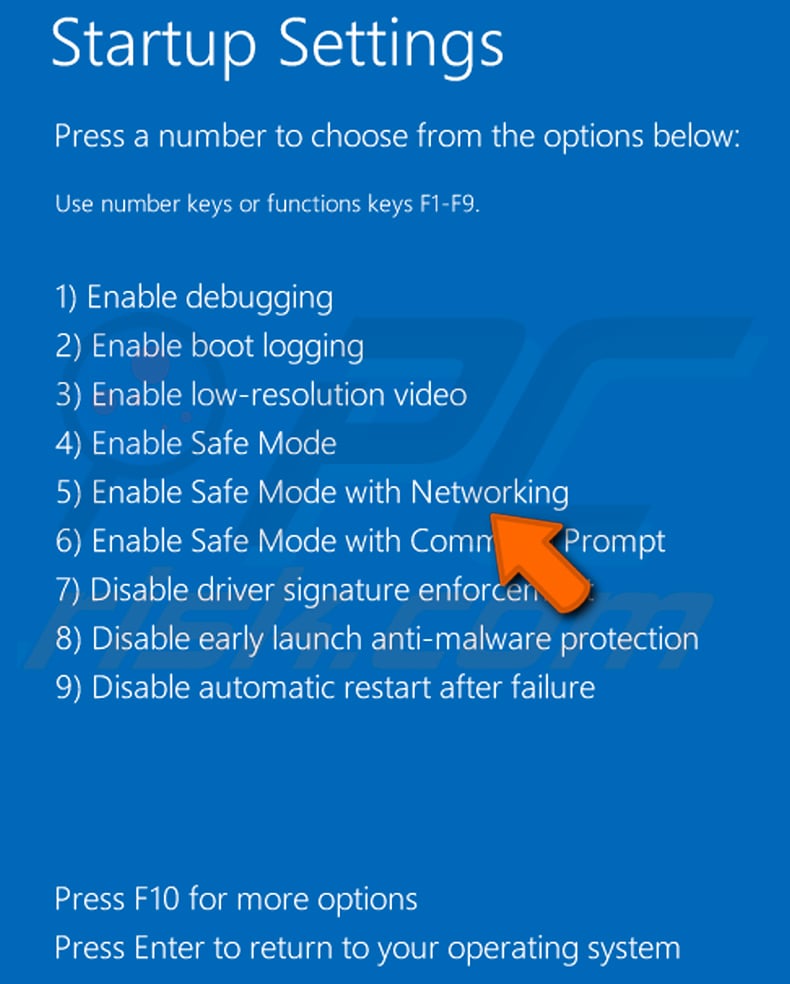
Video showing how to start Windows 8 in "Safe Mode with Networking":
Windows 10 users: Click the Windows logo and select the Power icon. In the opened menu click "Restart" while holding "Shift" button on your keyboard. In the "choose an option" window click on the "Troubleshoot", next select "Advanced options".
In the advanced options menu select "Startup Settings" and click on the "Restart" button. In the following window you should click the "F5" button on your keyboard. This will restart your operating system in safe mode with networking.
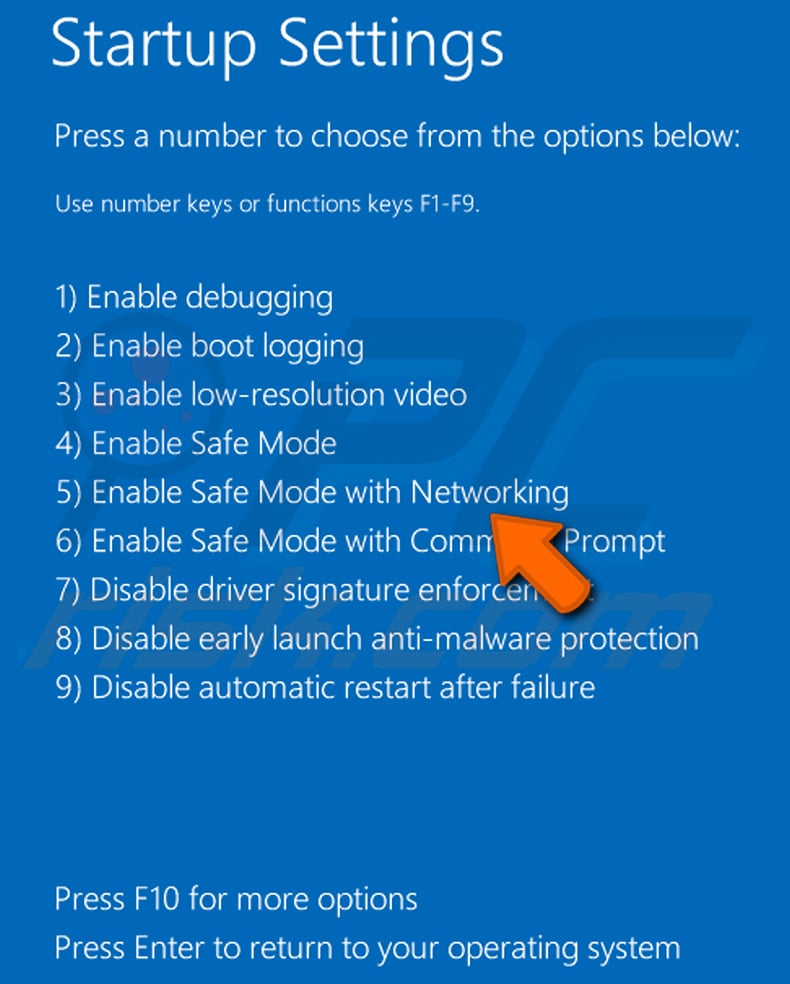
Video showing how to start Windows 10 in "Safe Mode with Networking":
 Extract the downloaded archive and run the Autoruns.exe file.
Extract the downloaded archive and run the Autoruns.exe file.
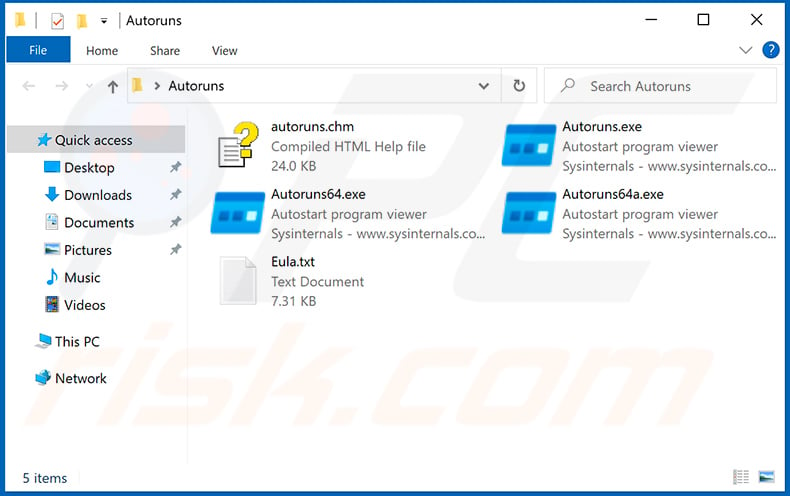
 In the Autoruns application, click "Options" at the top and uncheck "Hide Empty Locations" and "Hide Windows Entries" options. After this procedure, click the "Refresh" icon.
In the Autoruns application, click "Options" at the top and uncheck "Hide Empty Locations" and "Hide Windows Entries" options. After this procedure, click the "Refresh" icon.
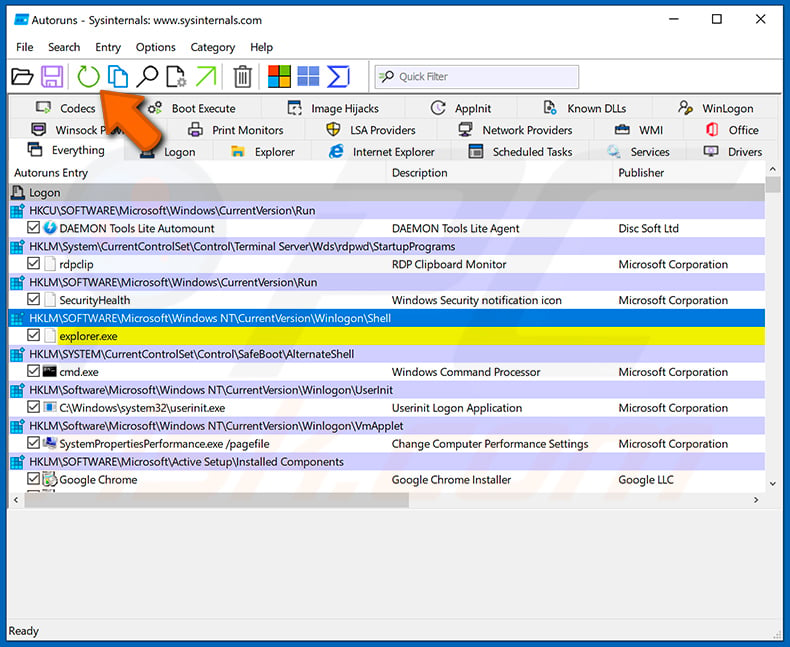
 Check the list provided by the Autoruns application and locate the malware file that you want to eliminate.
Check the list provided by the Autoruns application and locate the malware file that you want to eliminate.
You should write down its full path and name. Note that some malware hides process names under legitimate Windows process names. At this stage, it is very important to avoid removing system files. After you locate the suspicious program you wish to remove, right click your mouse over its name and choose "Delete".
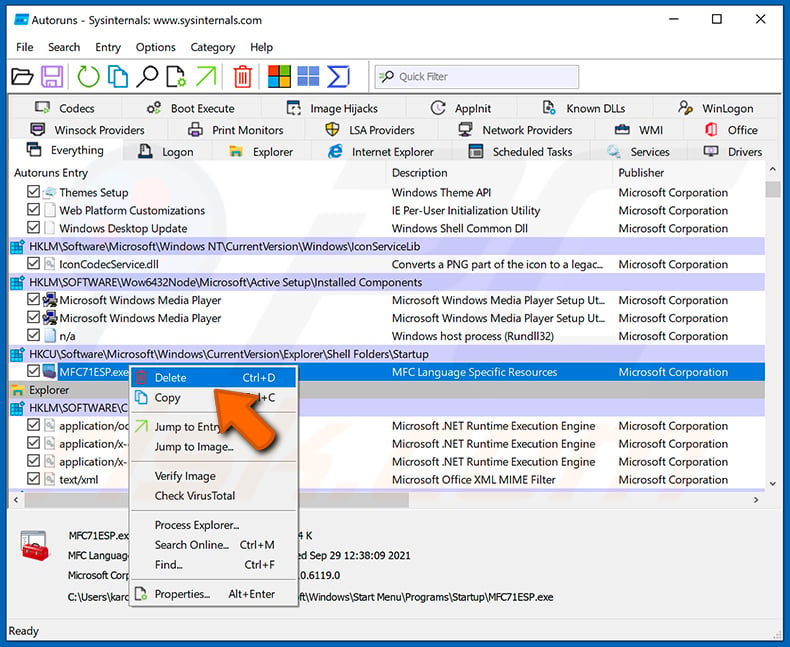
After removing the malware through the Autoruns application (this ensures that the malware will not run automatically on the next system startup), you should search for the malware name on your computer. Be sure to enable hidden files and folders before proceeding. If you find the filename of the malware, be sure to remove it.
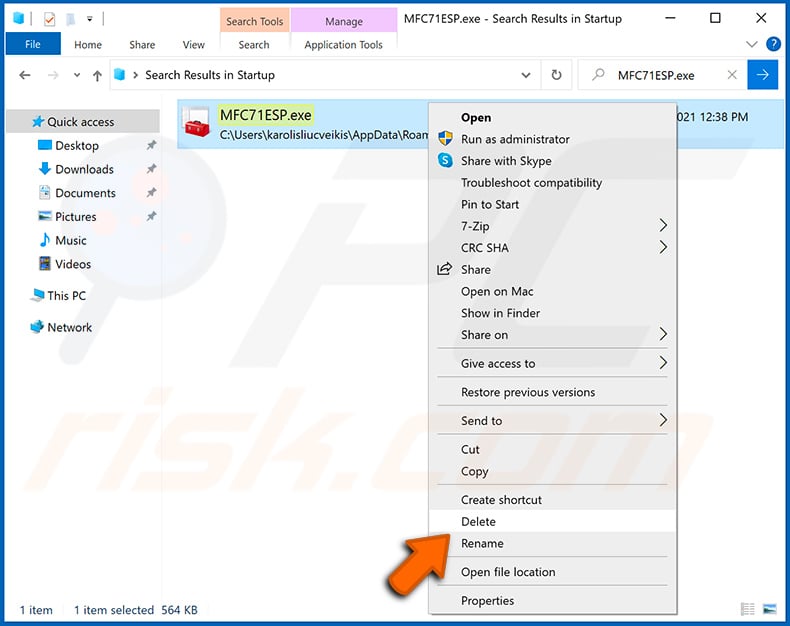
Reboot your computer in normal mode. Following these steps should remove any malware from your computer. Note that manual threat removal requires advanced computer skills. If you do not have these skills, leave malware removal to antivirus and anti-malware programs.
These steps might not work with advanced malware infections. As always it is best to prevent infection than try to remove malware later. To keep your computer safe, install the latest operating system updates and use antivirus software. To be sure your computer is free of malware infections, we recommend scanning it with Combo Cleaner Antivirus for Windows.
Frequently Asked Questions (FAQ)
My computer is infected with DarkCloud malware, should I format my storage device to get rid of it?
Malware removal rarely requires such drastic measures.
What are the biggest issues that DarkCloud malware can cause?
The threats associated with an infection depend on the malware's functionalities and the cyber criminals' goals. DarkCloud is a stealer that exfiltrates sensitive data from infected devices. Generally, stealers are linked to severe privacy issues, financial losses, and identity theft.
What is the purpose of DarkCloud malware?
Malware is primarily used to generate revenue. However, malicious software can also be used to amuse the attackers or realize their personal grudges, disrupt processes (e.g., sites, services, companies, etc.), engage in hacktivism, and launch politically/geopolitically motivated attacks.
How did DarkCloud malware infiltrate my computer?
DarkCloud has been spread via malspam. It could be distributed using other methods, aside from spam emails. Commonly used malware proliferation techniques include: drive-by downloads, trojans, untrustworthy download channels (e.g., freeware and free file-hosting sites, P2P sharing networks, etc.), malvertising, online scams, illegal software activation tools ("cracks"), pirated content, and fake updates. Some malicious programs can self-spread via local networks and removable storage devices.
Will Combo Cleaner protect me from malware?
Combo Cleaner is capable of detecting and removing most of the known malware infections. Note that performing a full system scan is crucial since sophisticated malicious programs tend to hide deep within systems.
Share:

Tomas Meskauskas
Expert security researcher, professional malware analyst
I am passionate about computer security and technology. I have an experience of over 10 years working in various companies related to computer technical issue solving and Internet security. I have been working as an author and editor for pcrisk.com since 2010. Follow me on Twitter and LinkedIn to stay informed about the latest online security threats.
PCrisk security portal is brought by a company RCS LT.
Joined forces of security researchers help educate computer users about the latest online security threats. More information about the company RCS LT.
Our malware removal guides are free. However, if you want to support us you can send us a donation.
DonatePCrisk security portal is brought by a company RCS LT.
Joined forces of security researchers help educate computer users about the latest online security threats. More information about the company RCS LT.
Our malware removal guides are free. However, if you want to support us you can send us a donation.
Donate
▼ Show Discussion